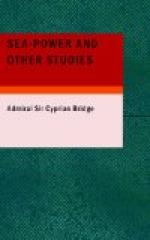-------------------------------------------------------
------ | | | Napoleonic War to | | | French | the end of the | | | Revolutionary War | Trafalgar year | | Classes of Ships |-------------------|-------------------| | |Commence-|Commence-|Commence-|Commence-| | | ment of | ment of | ment of | ment of | | | 1793 | 1801 | 1803 | 1806 | |-----------------------------------------------------------
--| | 3-deckers | 31 | 32 | 29 | 29 | | 2-deckers of 74 | 76 | 111 | 105 | 123 | | guns, and above | | | | | | 64 and 60 gun ships | 46 | 47 | 38 | 38 | | 2-deckers not ’fit | 43 | 31 | 21 | 22 | | to lie in a line’ | | | | | | Frigates 44 guns | 0 | 6 | 6 | 6 | | " 40 " | 0 | 5 | 5 | 4 | | " 38 " | 8 | 32 | 32 | 50 | | " 36 " | 16 | 49 | 49 | 54 | | " 32 " | 48 | 41 | 38 | 56 | | " 28 " | 27 | 11 | 11 | 13 | ------------------------------------------------------------
-
The liking for three-deckers, professed by some officers of Nelson’s time, seems to have been due to a belief, not in the merit of their size as such, but in the value of the increased number of medium guns carried on a ‘middle’ deck. There is, I believe, nothing to show that the two-deckers Gibraltar (2185 tons) and Coesar (2003) were considered more formidable than the three-deckers Balfleur (1947), Glory (1944), or Queen (1876). All these ships were in the same fleet, and fought in the same battle.]
A fleet of ships of the line as long as it could keep the sea, that is, until it had to retreat into port before a stronger fleet, controlled a certain area of water. Within that area smaller men-of-war as well as friendly merchant ships were secure from attack. As the fleet moved about, so the area moved with it. Skilful disposition and manoeuvring added largely to the extent of sea within which the maritime interests that the fleet was meant to protect would be safe. It seems reasonable to expect that it will be the same with modern fleets of suitable battleships.
The tactics of ‘single ship actions’ at the time of Trafalgar were based upon pure seamanship backed up by good gunnery. The better a captain handled his ship the more likely he was to beat his antagonist. Superior speed, where it existed, was used to ‘gain the weather gage,’ not in order to get a suitable range for the faster ship’s guns, but to compel her enemy to fight. Superior speed was also used to run away, capacity to do which




